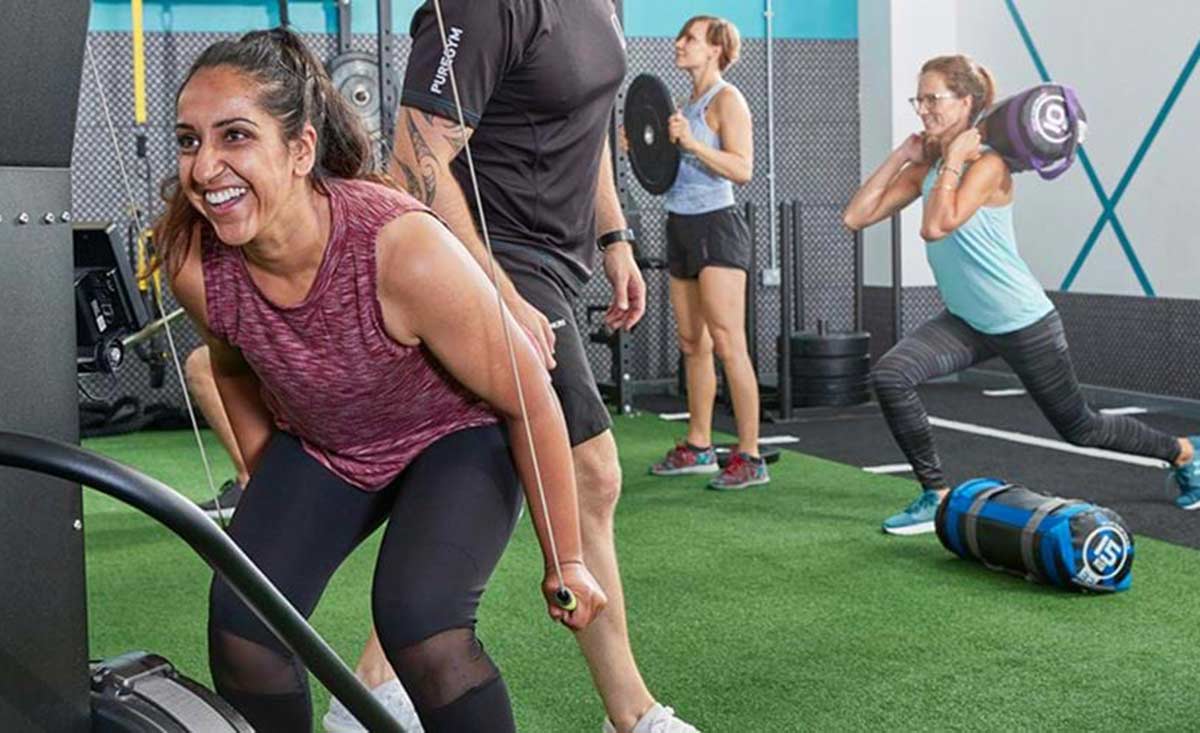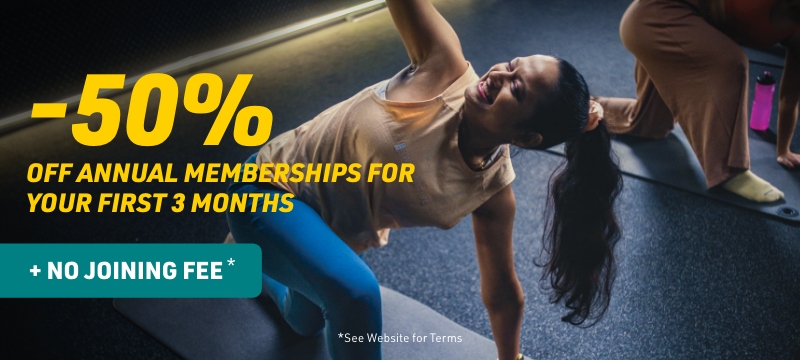One Hour Gym Workouts
Sticking to short, high-intensity sessions may be tempting when time is tight. But if you have specific goals in mind, carving out an hour to exercise brings with it fitness benefits that micro workouts just can’t replicate.
Even if gyms are closed, or you’d just rather work out at home, an hour gives you plenty of time for a well-rounded routine with a proper warm-up and cool down. You could do a full body workout, target specific areas or work on your cardiovascular endurance. Plus, having 60 minutes lets you build the intensity over the course of your workout session.
Whether you’re prepping for a triathlon or an obstacle race, regular one hour exercise sessions at the gym are an excellent step in the right direction. Longer sessions are perfect for honing specific techniques to get you over the finish line, letting you work on foot strike, breathing patterns, pedal rhythm or pull-ups, for example.
But for maximum return on your time investment, having a solid workout plan in place is key. Pre-planning lets you move around the gym with purpose, without wasting precious time wondering what to do next. Our 1 hour workout ideas below make a great starting point.
What Are The Benefits Of A One Hour Workout?
Whether squeezed into your lunch break or tacked onto your commute, one hour workouts can have huge benefits on your physical and mental wellbeing. Regular sessions that include both aerobic and resistance elements will put you well on your way to achieving (and even exceeding) the minimum amount of activity needed for good health.
HEPA Switzerland recommends adults should do 150-300 minutes of moderate exercise or 75-150 minutes of intense exercise a week, including both aerobic and strength training.
Regular exercise has many benefits including weight management, improved cardiovascular health, improved strength and muscle mass, healthy bone density, and reduced risk of chronic diseases.
Sixty minute sessions also allow time for a short stretching routine, helping you work on the third (and often overlooked) pillar of health after muscular strength and cardiovascular fitness: flexibility. From sprinters to bodybuilders, joint mobility is vital to athletic performance as it reduces the risk of injury and soreness. But it’s also important when it comes to maintaining posture and balance as we age, something that can significantly increase our quality of life.
How Many Calories Can You Burn In One Hour At The Gym?
The number of calories burned in a 1 hour gym workout depends on many factors such as your height, weight, body composition, so this number will vary person to person and the activity and intensity, so it will also vary workout to workout.
For example, if you weigh 11 stone (154 lbs, or just under 70kg), your estimated calorie burn is 224 calories for an hour’s weightlifting, 520 calories on either the stationary bike or rowing machine at a moderate intensity, 670 calories on the elliptical trainer or 744 calories for one hour on the treadmill running at 6mp.
Whilst it may be useful to know how much calories you might be burning to take into consideration your energy balance, tracking calories isn’t for everyone and it isn’t necessary. Completing a workout in order to reach a calorie target or exercising to burn calories would not be recommended and could do more harm than good, so it’s important to consider whether tracking would be beneficial for you.
How Many 1 Hour Gym Workouts Should I Do Per Week?
This depends on your needs, fitness abilities and goals.
If you haven’t exercised for some time or are new to working out, it’s a good idea to start with one to three one-hour gym workouts per week and focus on showing up consistently and then gradually build up from there if you want to.
Ask yourself how many sessions would be feasible for you to realistically stick to. Trying to squeeze in 5 workouts per week when you can only realistically manage 3 workouts per week will not be sustainable and would more likely leave you feeling a failure because you keep missing two workouts and forgetting that you are doing well by keeping active and going to the gym consistently three time per week.
If you are working our regularly, always make sure to include enough time for rest in-between sessions to allow your enough time to recovery from your gym workouts.
Is One Hour In The Gym Enough To Get Fit?
When it comes to building strength, an hour-long session is more than adequate for both beginners and intermediates. It will allow you time for a 5-10 minute warm-up, 40-45 minutes of training and 5-10 minutes of cooling down and stretching.
But is one hour enough to remain healthy? That all depends on what you do for the other 23. Even if you hit the gym every day, you’d still be classed as ‘sedentary’ if you then sat immobile in your work and leisure time, with all the health risks this incurs.
In addition to working out at the gym, aim to get up and move around throughout the day, and go on a couple of short walks to break up long periods of sitting.
Is A 60 Minute Workout Better Than A HIIT Session For Cardio?
This will depend on what your training and health goals are.
Short, super-high-intensity workouts can help to improve speed, strength, power and aerobic fitness, particularly if you’re short on time. However, performing high intensity workouts are likely to be more physically demanding which will likely mean you need more time to recovery from training. Ensure you get a good amount of rest in-between sessions.
Longer, less intense cardio sessions of up to an hour can help to improve cardiovascular endurance, lunge capacity and are usually not as physically demanding. This type of workout would likely mean you will need less time than HIIT training would require to recovery, so over the span of a week, you could do more running sessions.
Both workouts are valid. Do what is best for you and what’s aligned with your training goals.
Can I Do A One Hour Gym Workout Every Day?
You can, but you do need to be sensible. Lifting weights that target the same body part each day brings with it increased risk of injury and over-training. Without adequate recovery time you could overload your joints and tendons.
If you wish to weight train every day, consider targeting different parts of your body, such as upper and lower, and training them on alternate days. Or alternate the intensity of your sessions, with active recovery sessions in between more challenging cardio sessions, for example.
Remember, more doesn’t necessarily mean better results. Rest and recovery in-between session is just as important as your training. Make sure to allow yourself enough time to recover from your workouts.
What If I Don’t Have Time For A One Hour Workout?
Can’t block out an entire hour to exercise? Don’t sweat it, because doing something is always better than doing nothing. Time constraints are often cited as a barrier to exercise with many under the mistaken belief that if they don’t workout for a full hour, it’s not enough to benefit.
But while it’s true that you’ll see greater improvements the more work you put in, sometimes the biggest battle is just getting through the gym door. Even if you can only find time to work out for 20 minutes, it’s still worth going to remain consistent with your exercise habit.
1 Hour Cardio Workout
Boost your cardio fitness and running speed with this one hour interval treadmill workout.
What you’ll need: For this routine you’ll need a treadmill but you can use a ski-erg, assault bike, rower, exercise bike if you prefer.
How it works: During your run you’ll do short bursts at a higher intensity. We’ve used sprints, but you could just as easily adjust the incline on the treadmill to include some hill intervals. During the work periods, you should be exerting yourself hard enough that talking would be difficult, while during the rest period you should fully recover, even if that means walking instead of jogging.
The workout:
- Warm up with a light jog or brisk walk for 10 minutes
- Work: run for one minute, giving it an 8 out of 10 effort
- Recover: walk or jog for two minutes
- Repeat 10 times
- Cool down with a light jog or brisk walk for 5 minutes
- Stretch to cool down
1 Hour Strength Workout
This is a full body workout that builds strength and muscle mass in multiple muscle groups in one hour. Perform 2-3 a week and increase the weights or reps each week to continually challenge the muscles.
What you’ll need: For this routine you’ll need to use a barbell and dumbbells at weights that challenge you, but allow you to complete your reps. You’ll also need to have rest days in between sessions to rebuild muscle fibres and to avoid risk of injury.
How it works: Warm up your body. Then perform 8-10 reps of each of the exercises for 4 sets, concentrating on your form. Rest one minute in-between sets. You’ll also have time for a stretching routine at the end.
The workout:
- Squats
- Press ups
- Lunges
- Bent over rows
- Hip thrusts
1 Hour Kettlebell Workout
Kettlebell workouts give you a strength and cardio workout in one, helping to build full body fitness.
What you’ll need: For this routine you’ll ideally need two kettlebells, a lighter one for the upper body exercises, a heavier one for the leg work. If you’re a beginner, try a 6kg to 8kg kettlebell for the upper body, switching to a 10kg to 12kg for your legs. Not challenging enough? Start with a 10kg to 12kg kettlebell for your upper body, then try a 14kg to 16kg for your legs.
How it works: Warm up your body. Make sure your warm-up also includes slow, controlled wrist and neck circles, shoulder circles and glute activation exercises. Then perform one set of each kettlebell moves back-to-back to keep your heart rate up. Do the entire kettlebell workout three times then a short stretching routine at the end.
The workout:
- 10 kettlebell sumo squats
- 10 kettlebell single arm swings (each side)
- 10 kettlebell side lunges (each side)
- 10 kettlebell press and overhead tricep extensions
- Kettlebell plank drag-throughs, 40 seconds each
- 10 kettlebell V-sit Russian twists
These one-hour workouts make a great starting point, but if you’ve got a specific goal in mind, our Personal Trainers can help get you there. Book in a session and they’ll put together a personalised plan based on your aims and fitness level. Tight on time? Try one of our group classes. With cardio, strength building, circuits, HIIT and more, they let you workout for 20 to 60 minutes, so you don’t waste a single second.


